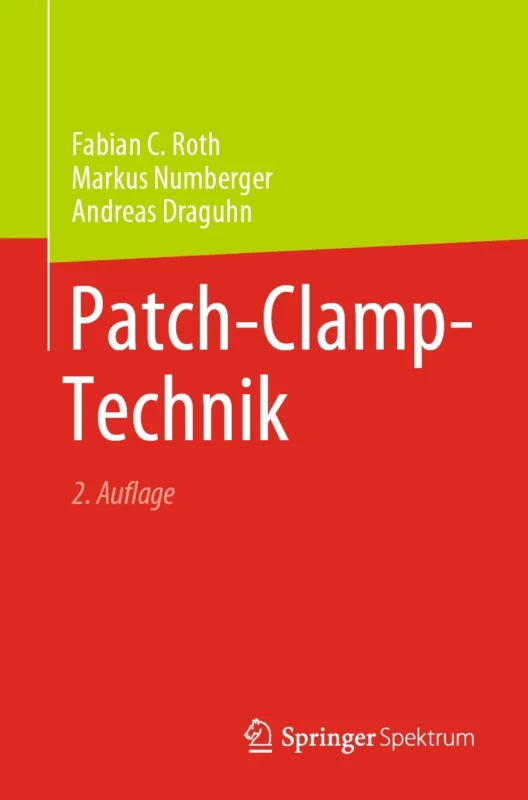Fabian Roth, Markus Numberger, Andreas Draguhn Patch clamp technique Springer-Verlag, Heidelberg. 2023 https://doi.org/10.1007/978-3-662-66053-9 ISBN: 978-3-662-66052-2
A review of our book "Patch Clamp Technique", written by Markos Xenakis and Angelika Lampert, was published in the Newsletter & Mitteilungsblatt der Deutschen Physiologischen Gesellschaft 12/2023 on December 21, 2023. The "Patch Clamp Technique", 2nd edition, by Roth, F.C., Numberger, M., and Draguhn, A. is a comprehensive, very successful manual on the patch clamp technique, a method for measuring the electrical activity of cells. It covers the history, theory, practice and applications of this technique and is suitable for both beginners and experienced electrophysiologists. Among other things, the book offers practical instructions for carrying out patch clamp experiments and for data processing. The first edition was already a standard work, and rightly so. Read here the complete book review by Markos Xenakis and Angelika Lampert from Aachen.

Review of the patch clamp technique, 2nd edition, by Roth, F.C., Numberger, M., and Draguhn, A
Markos Xenakis and Angelika Lampert
Since its Nobel Prize-winning description more than 40 years ago, electrophysiology, in particular the patch-clamp technique, has enjoyed widespread popularity, as this method allows the function of cells to be measured directly. Despite its relative complexity, it has therefore become a central method of physiological research. The range of applications resulting from theoretical and practical aspects of the patch-clamp technique has permeated several areas of biology, chemistry and medicine and has led to clinically significant interdisciplinary applications such as ion channel pharmacology.
In this second edition of "Patch Clamp Technique", the authors Fabian C. Roth, Markus Numberger and Andreas Draguhn build on the first edition of the book published over 25 years ago and provide a concise, educational and practical overview of the patch clamp technique. The book is an excellent read for both experienced electrophysiologists and beginners. The simple, informal style of the text promotes intuitive understanding while elegantly summarizing complicated technical and biophysical concepts.
In the lively first chapter, the authors provide a historical outline of the processes that led to the development of the patch clamp technique. Numerous quotations enliven the text and it is clear that the authors themselves know some of the key players in this development and have actively followed or helped to shape the methodological progress. Details on the review process of the Nobel Prize-winning work in Pflüger's archive (O. Hamill et al. 1981) are probably not only encouraging for the younger scientists among us. It is remarkable that the authors manage to tell the story of the patch-clamp technique in such a captivating way and thus arouse interest in the following chapters.
The fundamental aspects of bioelectricity and measurement theory are also explained concisely with key concepts (membrane potential, capacitance, resistance and action potential) together with the Nernst equation and Ohm's law. Successful examples deepen understanding and physical formulas are presented in such a way that they are easy to understand and should no longer deter any reader. The outlook on other electrophysiological methods at subcellular, cellular and whole organ level (e.g. EEG), which are briefly summarized in an informative table, is also very well done.
The third chapter offers the reader a tour through the technical and biophysical basics of the patch-clamp technique. The focus is on the signal amplification method and its functional and biophysical significance in voltage and current clamp experiments. The practical advice on compensating for measurement artifacts caused by capacitance, series resistance and offset potentials is very practical and helpful. All the illustrations in the book are clear and illuminating. They make the techniques appear simple and logical. Even complex issues such as series resistance compensation, which often trigger flight reflexes in students, are presented in this book with such simple clarity and explained step-by-step that all fear of contact disappears.
With a practical "how-to" guide, in which hardly a detail is left unmentioned despite its brevity, the authors describe in detail how to set up a measuring station. From the selection of optical components, the construction of the measuring table and measuring chamber and their electromechanical support to micromanipulators, glasses and pipettes, and preparations for solutions, the reader receives well-founded information, accompanied by concrete examples and advice.
In the chapter on patch-clamping practice, the reader is guided step-by-step through the procedure for producing a patch-clamp derivative. Here, too, the authors succeed in giving numerous examples and tips that make the reading easy to understand and create a "hands-on" atmosphere. Various experimental patch clamp configurations are covered in detail and finally the reader learns how to deal with interfering signals and apply filtering techniques. This chapter can be given directly to students. In contrast to conventional protocols, it ensures that practical implementation is coupled with a deeper understanding of the method.
The outlook on special applications of patch-clamp techniques - be it in vivo derivations or automated patch arrays, loose-patch and perforated-patch and pipette-based methods for intracellular substance delivery, dynamic-clamp, or simultaneous patch-clamp recordings of several cells - is also successful and helpful.
Finally, alternative uses of the pipette are presented, for example for histological staining and single-cell RT-PCR applications. Almost no variation of the patch-clamp technique is left unmentioned and the description allows even the inexperienced reader to get to grips with the concepts and makes them want to apply the techniques themselves.
Finally, in the last chapter, the book gives advice on documenting, storing and sharing experimental data, taking into account the principles of openness and transparency. Here it is evident that the authors have decades of experience in data generation using the patch-clamp method.
The authors manage to convey important insights and practical tips in an educational way, adding depth and quality without compromising readability, in a balanced text using simple yet dense and concise language.
In summary, it can be said that this introduction to the patch clamp technique is simply a success. The first edition was already a standard work, and rightly so.
